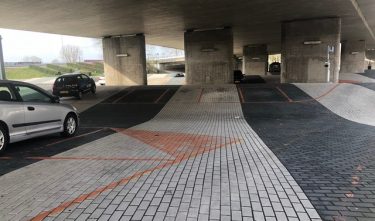In the euphoria surrounding nominations and winning awards, thoughts on the long-term valuation of a design often do not come to the fore. Understandably so. But that this aspect and the consensus on the long-term appreciation of design are sometimes hard to find, is demonstrated by recent discussions and even court cases.

The lawsuit concerns summary proceedings against Evides Water Supply Company in Rotterdam, instituted by architect and former government architect Wim Quist. According to the architect, the case involves a planned new building that threatens to disfigure his original 1977 design irreparably. In addition, a work of art by André Volten must make way for a new car park.
A second issue concerns the appreciation and future of a well-known design in Arnhem. Peter Struycken designed the Blue Waves here, coincidentally also in 1977. A work of art with an area of 25 thousand square metres that lies under and around the traffic intersection on the centre side of the Nelson Mandela Bridge. The future of this undulating, blue and white paved area, which is partly used as a car park, is under pressure because the municipality plans to transform it into a ‘green corridor’. This is in keeping with the prevailing trend of greening our living environment. Art students from the ArtEZ college made a revealing documentary about it, directed by artist Hans van Houwelingen.
column continues below video
Both issues are illustrative examples of the vulnerable position in which a design can end up when insights about the value and meaning of the work itself or the context change. It also shows that appreciation can change dramatically after the intoxication of designing or after winning a prize or award.
Almost nobody then, understandably, makes a point of the lifespan or durability of the designed object. Unless, of course, durability and longevity are the central themes.
This blind spot is perfectly logical. To refer to it directly would also bear witness to an excessively advanced degree of suspicion. The underlying idea and the design itself arise from a direct response to a current assignment or answering an urgent question. A successful design derives its power from the accuracy of its interpretation of a moment. The power and distinctiveness of a good design lie in its timeliness. Good design is, by definition instantaneous, it is proper. The starting point and ending point always coincide.
But that doesn’t tell the whole story about design and time because that’s what this is about. After all, time is dynamic and designs sometimes relate to this continuous movement of events and insights. Once designed, a design remains static. It solidifies and stays behind with time. The exception to this rule is exceptional designs that become iconic or timeless. Time has no hold on them. They are inviolable in a changing context, above reproach and protected against demolition or damage. However, this honour is only reserved for a limited number of designs and designers. Much more often, a design loses its original value and meaning over time. The shine disappears, and it peels off. The knowledge of the reason fades.
This loss of knowledge, context and meaning can have far-reaching consequences, as the examples cited show. The most dramatic variant is when a design disappears entirely into oblivion. But much more often, the view of its initial value is obscured by developments that take place after its conception. Questions are then raised where none existed before. The constant here is that time, and again it becomes apparent how vulnerable a design is after a while. Original values do not always offer protection. Much more often, design suffers loss in the battle against the day’s issues when judgements are made too quickly or too superficially.
At the risk of being labelled a preservative, a plea for greater self-evidence in timeless design is opportune. In a world that is changing ever more rapidly and radically, existing designers, and perhaps especially those in the public space, should be cherished much more often as static resting places. After all, they have already proved their worth and should be protected, more so than is the case now, against damage and ignorance as a result of the passage of time. Let us, therefore, start awarding the predicate timeless to many more existing designs. Starting with the winners of Dutch Design Awards.
JaapJan Berg, chair expert panel Habitat